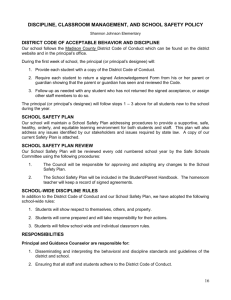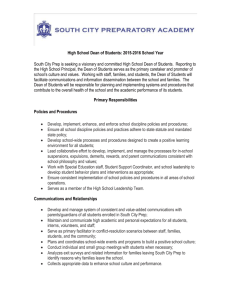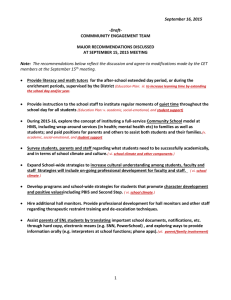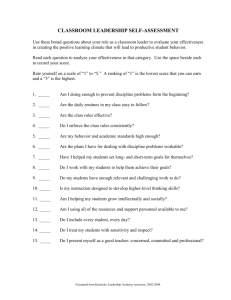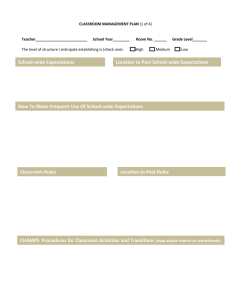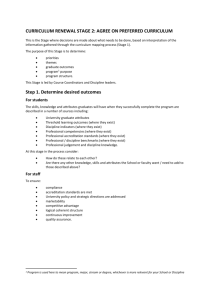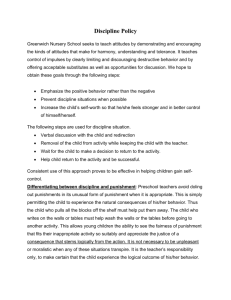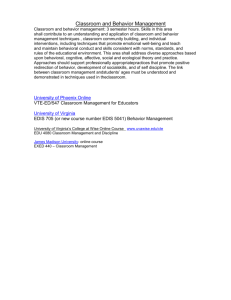School-wide Discipline Parent Handbook
advertisement
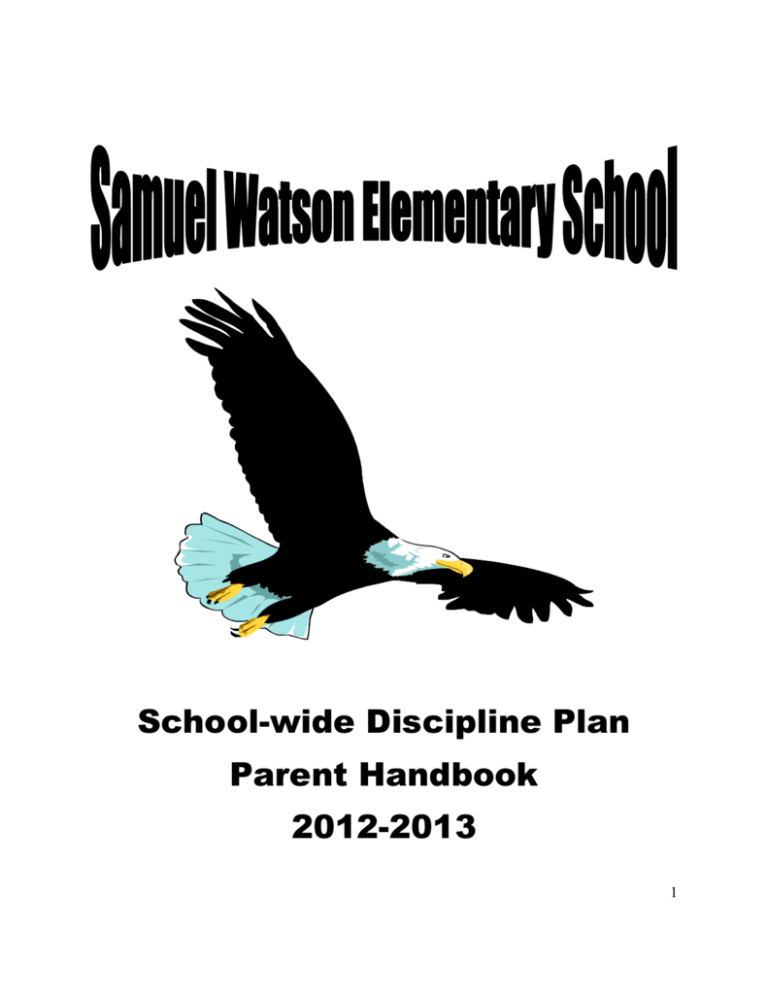
School-wide Discipline Plan Parent Handbook 2012-2013 1 Table of Contents School-wide Discipline Plan Rationale and Philosophy 3 Securing Staff Agreement and Active Support 5 Securing Parent and Student Agreement and Active Support 7 Behavioral Expectations 9 Defining Unacceptable Behavior 13 Behavior Flowchart 14 Consequences for Minor and Major Incidents 15 Positive Support System 16 Notice of Receipt of Discipline Plan- signature required 17 Parent/guardian and student, you are responsible for knowing the contents of this document. Please read and discuss the information together. Thank you!! This handbook provides information about the policies and procedures of our School-wide Discipline Plan. When parents, students and teachers work together toward a common goal, a more enjoyable school experience will happen. The goal of our plan is to help our students be successful. Discipline plays a huge role in a child’s education. It is a life-long skill children will rely on as they become active members of their community. Our students deserve the most positive learning environment to achieve academic success. Therefore, this school-wide discipline plan will be in effect at all times. 2 Samuel Watson School School-wide Discipline Plan What is a School-wide Discipline Plan? A School-wide Discipline plan is an organized, data-driven system of interventions, strategies and supports that positively impact school-wide and individualized behavior planning. What are the benefits of a School-wide Discipline Plan? A systematic approach to discipline enhances learning outcomes for all students. By reinforcing desired behavioral outcomes students will clearly understand expectations. Students are explicitly taught what the desired behavior should be. This attention to expectations leads to a more positive classroom experience, a stronger learning community and an increase in student learning. Defining Discipline: Discipline is a process that uses teaching, modeling and other appropriate strategies to maintain the behaviors necessary to provide a safe, orderly and productive learning environment by changing unacceptable behavior to acceptable behavior. 3 Our teachers and staff will provide all students with an enriching, challenging and nurturing learning atmosphere each year. Each teacher has a classroom management plan to address procedures and discipline in the classroom. This plan includes positive rewards. Please make sure you and your child understand these rules and procedures. If you have any questions, please do not hesitate to contact your child’s teacher. If your child’s teacher contacts you about a discipline concern for your child, please be supportive and responsive to work with us, so that your child’s behavior has a positive outcome. S O A R top and listen attentively pen the door to making good choices ct responsibly espect Beliefs Related to Discipline at Watson Elementary School: The misbehavior of one student will not be allowed to interfere with the learning opportunities of other students. The misbehavior of a student will not excuse him/her from successfully completing learning objectives. Every discipline is an opportunity to teach expected behavior. Expected behavior must be communicated, taught and modeled throughout the school year. Parents have a responsibility to ensure that their children’s behaviors do not take away from a safe, orderly and academically productive learning environment of others. 4 The Classroom Teacher’s Commitment Teachers will: Enforce the School-wide Discipline Plan as agreed Communicate high behavioral expectations to students and parents Commit to follow through to the success of student behavior Take responsibility for classroom problems and behavior Foster a school climate characterized by a concern for students as individuals Take an interest in the personal goals, achievements and needs of their students Support the students in their academic and extracurricular activities Staff Member’s Commitment Staff members will: Enforce the School-wide Discipline Plan as agreed Communicate high behavioral expectations to students Commit to follow through to the success of student behavior Take an interest in personal goals, achievements and needs of students Support the students in their academic and extracurricular activities. Administrator’s Commitment Administrators will: Support the teachers in this new system Model high behavioral expectations Maintain a school climate in which everyone wants to achieve self-discipline Foster a school climate where the administration is sincerely concerned for the staff and students as individuals Take an interest in personal goals of teachers, staff and students 5 Watson Elementary School Community’s Commitment Be specific: tell the student exactly what they did Be timely: don’t wait to praise or correct Be sincere: insincere praise is usually worse than none at all Be consistent: with everything, everywhere Communicate: keep open lines of communication open between home and school Securing Parent and Student Agreement and Active Support The success of a school-wide system lies in the relationship built between parents, staff and students of the school community. This relationship begins with communication. Parents 6 will be informed about current school issues, success and concerns through school-wide newsletters, classroom teacher’s updates, the school website, parent meetings and parent handbooks. The hope is by keeping parents well-informed the plan will be more successful. On an individual basis student behavioral issues are addressed with parents through the parent/teacher emails, notes home, phone calls home and parent conferences. A signature is required for any written notification concerning behavior. The signature helps school staff know that the parent is aware of the concerns being raised and is the beginning of establishing an open line of communication. This communication helps to foster the success of the school-wide plan. Watson Elementary School’s school-wide plan will be successful because it is based on a commitment to each child’s success, to easy-to-follow school rules and to consistency. The system allows for each teacher’s style in the classroom and it allows for age appropriate communication and discipline without compromising school-wide policies, expectations and consistency. Parent’s Commitment Parents will: Reinforce the School-wide Discipline Plan Communicate high behavioral expectations to their child Commit to follow through to the success of their child’s behavior Take an interest in personal goals, achievements and needs of their child Support the students in their academic and extracurricular activities. Student’s Commitment Students will: Follow the School-wide Discipline Plan Maintain high behavioral expectations Accept responsibility for your behavior Set personal goals and work hard to achieve them 7 Behavioral Expectations The following chart explains Watson Elementary School’s Behavioral Expectations. At the beginning of the year students will be explicitly taught these expectations. Our expectations will be reinforced throughout the year. Our goal is through these easy-to-follow expectations a positive learning atmosphere will be established throughout the school. Arrival/Dismissal Stop and listen attentively Open the door to making good choices Act responsibly Respect self and others Stop, listen and follow directions when an adult speaks to you Quiet stairways and hallways Walk quietly to your destination/patrol Walk on the right side of the stairs during arrival Be aware of your surroundings Enter and exit quietly Walk when you enter and exit the building Pay attention and keep the line moving during dismissal Be on time Be prepared/know how you are getting home Listen and follow the directions of the safety patrol leaders Keep hands and feet to yourself at all times Use indoor voices Walk appropriately to and from cars/buses Hallway Stop and listen attentively Open the door to making good choices Act responsibly Respect self and others Stop, listen and follow directions when an adult speaks to you Respond immediately to “Peace and Quiet” signal Be aware of your surroundings Stay in line Hands by your side Walk silently Pay attention and keep the line moving Proceed directly to destination Remain with your teacher at all times Report any problems or inappropriate behavior to an adult Keep hands and feet to yourself at all times Keep silent in the hall at all times 8 Classroom Stop and listen Stop, listen and follow directions when an adult speaks to you Respond immediately to “Peace and Quiet” signal attentively Open the door to making good choices Act responsibly Respect self and others Raise hand and wait to be acknowledged before speaking Do your best Treat others the way you want to be treated Participate in class Be on time Be prepared Complete assignments in school and at home Remain on task in the classroom Respond kindly and appropriately with peers Follow school and classroom rules Keep hands and feet to self Be patient and wait your turn Clean up after yourself Bathroom Stop and listen Stop, listen and follow directions when an adult speaks to you Respond immediately to “Peace and Quit” signal attentively Open the door to making good choices Act responsibly Respect self and others Report any inappropriate behavior Use inside voices Use restroom time wisely Enter restroom quietly Exit restroom quietly Clean up after yourself Flush toilet Wash your hands with soap and water Place paper in trash Give others privacy Wait patiently for your turn Keep your hands and feet to yourself at all times Be considerate of others in the restroom 9 Playground Stop and listen attentively Open the door to making good choices Act responsibly Respect self and others Stop, listen and follow directions when an adult speaks to you Respond immediately to “Peace and Quiet” signal STOP and walk to line when the bell rings Play only in designated areas (stay away from dumpster, hill, wall and fenceline) Be polite at all times Be honest Use appropriate language Report any bullying or inappropriate behavior to an adult Keep hands and feet to yourself at all times Play kindly and appropriately with others Indoor Recess Stop and listen attentively Open the door to making good choices Act responsibly Respect self and others Stop, listen and follow directions when an adult speaks to you Respond immediately to “Peace and Quiet” signal Clean up your play area when the bell rings Choose your play area wisely Stay in your chosen play area Be polite at all times Be honest Use indoor voices Use appropriate language Report any bullying or inappropriate behavior to an adult Keep hands and feet to yourself at all times Play kindly and appropriately with others 10 Lunchroom Stop and listen attentively Open the door to making good choices Act responsibly Respect self and others Enter lunchroom quietly Stop, listen and follow directions when an adult speaks to you Respond immediately to “Peace and Quiet” signal Choose entrée quickly and progress through line Get utensils and condiments Remain at assigned table Refrain from playing with food and other items Use disinfectant to clean hands before getting lunch Stay in single file when walking in the lunchroom Stop talking when all the classes have entered the cafeteria Hand in lunch tickets Stop talking when preparing for dismissal from cafeteria Clean around your sitting area and on the floor Use good manners while eating Eat only your food; do not share your food Respect others and their space at the table Assemblies/Field Trips Stop and listen Stop, listen and follow directions when an adult speaks to you Respond immediately to “Peace and Quiet” signal attentively Open the door to making good choices Act responsibly Respect self and others Enter and exit quietly Remain with your teacher and class/group Do your best Follow school and classroom rules Obey staff members on bus and at destination Represent your school in a positive manner Ask appropriate questions Respect all adults Be patient and wait your turn Respect materials and property 11 Defining Unacceptable Behaviors There are two levels of behaviors: minor and major. Minor behaviors will be addressed and handled by teachers. Major behaviors will be referred to the office to be handled by the counselor or principal. (See flowchart on page 14) The following table defines minor and major behavior concerns. Behavior Deface Disrespect toward a peer Minor Something that can be removed, cleaned, or fixed. Mildly rude interactions with a peer or peers that may cause a slight upset. Disrespect toward a staff member/adult. Mildly rude interactions with a staff member/adult that may cause a slight upset. Endanger Minor injury to others. Disregard the safety of others. Slight disruption that hinders the learning of others. Profanity exclaimed, not intended at an individual. Inappropriate Behavior Inappropriate Language Insubordination Spiritwear Violation Wandering Failure to follow directions in a reasonable amount of time. Wearing spiritwear, but may have uniform pieces missing (ex. Open toed shoes, wrong t-shirt). Wandering the classroom. Major Inability to clean or fix. Rude and deliberate interactions or arguing with a peer or peers that is offensive to the peer/peers. Rude and deliberate interactions or arguing with a staff member/adult that is offensive to the staff member/adult. Major injury- a physical mark, causing someone pain. Continued or physical disruption that hinders the learning of others. Continuous swearing, offensive gestures or comments directed at an individual Continued refusal to follow direction or arguing with an adult. Refusing to wear spiritwear. Leaving an area without permission. 12 Behavior Flowchart The flowchart outlines how staff will handle reported behavior concerns. 13 Consequences for Minor and Major Incidents When students do not follow the outlined school-wide discipline plan they will receive consequences based on the philosophy of progressive discipline. Progressive discipline uses a consistent approach that starts with a minor consequence for first offenses to a more severe consequence for repeat offenses. Minor behavioral issues will be handled by the teacher (classroom, art, music or phys ed). They will use their discretion when they believe the classroom behavior requires a referral. The following is a sampling of the consequences teachers may use: Redirection Removal to a “time out” area within the classroom Written referral Conference with student Note to parent Phone call to parent Teacher detention (morning or afternoon) Removal to another setting (no longer than 30 minutes) Major offenses will be handled by an administrator. Each child is an individual whose needs will be considered when determining the consequence. The following is a sampling of the consequences administrators may use: Natural consequence (clean desk that student wrote on, letter of apology, etc.) Parent phone call Referral to Discipline Team to develop a behavior improvement plan Alternative recess (only used when issue takes place during recess) Detention (morning/afternoon) Suspension (in-school or out of school) Referral to Mobile Crisis Unit Referral to Juvenile Court 14 Positive Support System This component of the school-wide discipline plan is to recognize students for meeting school behavioral expectations. Four incentive programs will be in place to acknowledge students who meet our expectations. The incentive programs are: Student of the Month Award Assemblies One student per teacher will be recognized for exhibiting the “Character of the Month”. Parents of students receiving Student of the Month will be invited to attend a breakfast award ceremony. Perfect Attendance At the end of each month, all students with perfect attendance for that month will have their name submitted for a drawing. They will receive a certificate and a book of their choice. At the end of the year, students who have had perfect attendance for the entire year will enjoy an ice cream party. Star Student Celebrations Our goal is that all students follow school-wide behavior expectations. When we observe them being safe, treating others with kindness, trying their best and being respectful, we acknowledge them by giving positive verbal feedback and a ‘punch’ on their star card. At the end of each quarter, students who have earned all their stars will be invited to participate in an activity (Popcorn and a movie, game hour, extra gym, recess and crafts). Notice of Receipt of School-wide Discipline Plan The School-wide Discipline Plan has been written so that students and family members know what behavior is expected. It is helpful when parents are aware of school rules so they can help support our school from home. Please sit down and talk about these rules with your child(ren). Failure to return this notice of receipt will not relieve students or parents from the responsibility for knowledge of the Watson Elementary School-wide Discipline Plan. 15 I have read the Watson Elementary School-wide Discipline Plan and discussed with my family. I understand my child is responsible for abiding by the Fall River School Department Code of Student Conduct as well as the Watson Elementary Schoolwide Discipline Plan. __________________________________________________________________ Parent/Guardian Signature Date __________________________________________________________________ Student Signature Date 16
